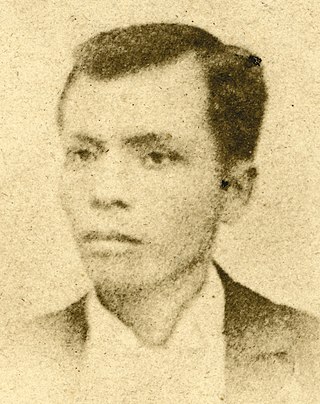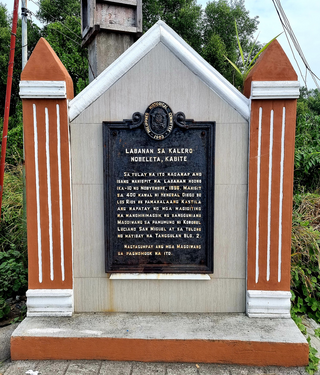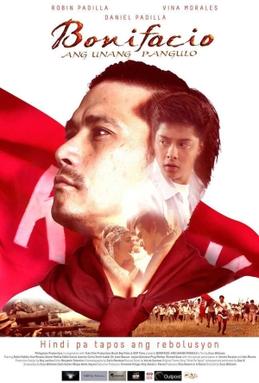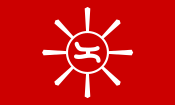
Emilio Aguinaldo y Famy was a Filipino revolutionary, statesman, and military leader who is the youngest president of the Philippines (1899–1901) and became the first president of the Philippines and of an Asian constitutional republic. He led the Philippine forces first against Spain in the Philippine Revolution (1896–1898), then in the Spanish–American War (1898), and finally against the United States during the Philippine–American War (1899–1901).

The Katipunan, officially known as the Kataastaasan Kagalang-galang na Katipunan ng mga Anak ng Bayan and abbreviated as the KKK, was a revolutionary organization founded in 1892 by a group of Filipino nationalists Deodato Arellano, Andrés Bonifacio, Valentin Diaz, Ladislao Diwa, José Dizon, and Teodoro Plata. Its primary objective was achieving independence from the Spanish Empire through an armed revolution. It was formed as a secret society before its eventual discovery by Spanish authorities in August 1896. This discovery led to the start of the Philippine Revolution.

Andrés Bonifacio y de Castro was a Filipino revolutionary leader. He is often called "The Father of the Philippine Revolution", and considered a national hero of the Philippines.

The Philippine Revolution was a war of independence waged by the revolutionary organization Katipunan against the Spanish Empire from 1896 to 1898. It was the culmination of the 333-year colonial rule of Spain in the archipelago. The Philippines was one of the last major colonies of the Spanish Empire, which had already suffered a massive decline in the 1820s. Cuba rebelled in 1895, and in 1898 the United States intervened and the Spanish soon capitulated. In June, Philippine revolutionaries declared independence. However, this was not recognized by Spain, which sold the islands to the United States in the Treaty of Paris.

Baldomero Aguinaldo y Baloy was a leader of the Philippine Revolution. He was the first cousin of Emilio Aguinaldo, the first president of the Philippines, as well as the grandfather of Cesar Virata, a former prime minister in the 1980s.

Mariano Malia Álvarez was a Filipino revolutionary and statesman.

Mariano Trías y Closas is considered to be the first de facto Philippine Vice President of that revolutionary government established at the Tejeros Convention - an assembly of Philippine revolutionary leaders that elected officials of the revolutionary movement against the colonial government of Spain. When that assembly broke into factions, a truce known as the Pact of Biak-na-Bato was signed by the group and also recognized the elected officials and Trias as the vice president of Emilio Aguinaldo, who is also considered to be the first President of the Philippines. With the promulgation of the Malolos Constitution by the Malolos Convention, the First Philippine Republic was born. Under the Aguinaldo administration, Trias served in the cabinet initially as Secretary of Finance and, later, as Secretary of War.

The Tejeros Convention, also known as the Tejeros Assembly and the Tejeros Congress, was a meeting held on March 22, 1897, between Katipunan factions of Magdiwang and Magdalo in San Francisco de Malabon, Cavite that resulted in the creation of a new revolutionary government that took charge of the Philippine Revolution, replacing the Katipunan. It followed on a previous meeting now known as the Imus Assembly. Filipino historians consider the first presidential and vice presidential elections in Philippine history to have been held at this convention, although only Katipuneros were able to take part, and not the general populace.

Pío del Pilar was a Filipino revolutionary general. He was one of the lead figures in the Philippine Revolution, and fought major battles in Manila and Cavite.

The Magdiwang was a faction of the Katipunan, a Philippine revolutionary organization founded by Filipino rebels in Manila in 1892 with the aim to gain independence from Spain. The Magdiwang Council was acknowledged as "the supreme organ responsible for the successful campaigns against the enemy" within Cavite.

General Licerio Topacio (1839–1925) was a leader in the Philippine independence movement.
Daniel Tirona y Tria was a Filipino politician. He became infamous for causing divisions within the Philippine revolutionary movement and for insulting and maligning Andres Bonifacio during the Tejeros Convention in 1897.
Procopio Bonifacio y de Castro was a Filipino independence activist and revolutionary during the Philippine Revolution of 1896 against Spain. He was a member of the secret revolutionary society turned revolutionary government Katipunan with his other siblings Ciriaco and Espiridiona. His eldest brother Andrés Bonifacio was one of the founders and, eventually, president of the Katipunan.
The Imus Assembly was the meeting held between the Magdalo and Magdiwang factions of the Katipunan at Imus, Cavite, Philippines, on December 31, 1896, the day following the execution of José Rizal. This was convened in order to settle the leadership dispute between the two factions.

The Battle of Binakayan–Dalahican was a simultaneous battle during the Philippine Revolution that was fought on November 9–11, 1896 that led to a decisive Filipino victory. The twin battle took place at the shores of Binakayan, in the town of Cavite Viejo ; Dalahican and Dagatan in Noveleta; and, to minimal extent, in Imus and Bacoor towns in Cavite, Philippines that lasted for two days before the Spanish army retreated demoralized and in disarray. The result of the battle was the first significant Filipino victory in the country's history.

The Battle of Noveleta known as Battle of Calero Bridge was a major battle during the Philippine revolution and was one of the first engagements of the revolution in Cavite. In the latter part of the revolution, Noveleta played a key role for the Magdalo and Magdiwang factions. From its capture by the Magdiwang at the start of the revolution, various battles were fought and won by Filipino rebels in Cavite. Noveleta became the seat of the Magdiwang faction of the Katipunan.
The Marangál na Dalit ng̃ Katagalugan is a song of the Philippine Revolution composed in November 1896 by Julio Nakpil at the request of Andres Bonifacio as the anthem of the revolutionary Tagalog Republic. However, this nascent revolutionary government was displaced and superseded by a succession of revolutionary governments headed by Emilio Aguinaldo and the composition known today as Lupang Hinirang became the national anthem of the Republic of the Philippines.

The Roderico Reyes Ancestral House, more commonly known as the Bonifacio Trial House, is a historic house and museum in Maragondon, Cavite, Philippines. It was built in 1889 and served as a military court, wherein it has been a witness to the trial of Andres Bonifacio in 1897.

Bonifacio: Ang Unang Pangulo is a 2014 Philippine historical action drama film centering on the life of Katipunan revolutionary Andres Bonifacio. It was an official entry to the 40th Metro Manila Film Festival.
This is the timeline of the Philippine Revolution—the uprising that gave birth to Asia's first republic. The roots of the revolution trace back to the Cavite mutiny and subsequent execution of Gomburza in 1872, and ended with the declaration of independence from Spain in 1898.
















